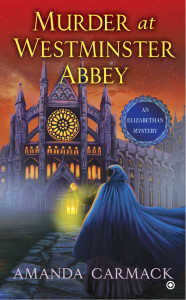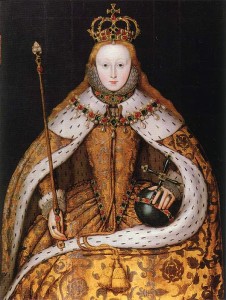 Carmack once again delves into the Elizabethan Age, in all its drama, treachery, and religious mania, with this richly textured second outing for court musician Kate Haywood (after 2013’s Murder at Hatfield House)…In Carmack’s hands, this period whodunit is deliciously detailed but never heavy-handed. –Publishers Weekly
Carmack once again delves into the Elizabethan Age, in all its drama, treachery, and religious mania, with this richly textured second outing for court musician Kate Haywood (after 2013’s Murder at Hatfield House)…In Carmack’s hands, this period whodunit is deliciously detailed but never heavy-handed. –Publishers Weekly
Hello, Riskies! I have been buried in my writing cave for a few weeks (thanks for all our lovely guest bloggers filling in!), but now I have to pop up to say…I have a new book coming out! Murder at Westminster Abbey, book two of my Kate Haywood Elizabethan Mysteries, is out April 1! It’s up for pre-order at Amazon, but I will be giving away one signed copy to a commenter on today’s post. Here’s a look at just a little of the fun research I did on the coronation of Elizabeth I…
1559. Elizabeth is about to be crowned queen of England and wants her personal musician Kate Haywood to prepare music for the festivities. New to London, Kate must learn the ways of city life
and once again school herself as a sleuth.
Life at the center of the new royal court is abuzz with ambition and gossip—very different from the quiet countryside, where Kate served Elizabeth during her exile. Making her way among the courtiers who vie for the new queen’s favor, Kate befriends Lady Mary Everley. Mary is very close to Elizabeth. With their red hair and pale skin, they even resemble each other—which makes Mary’s murder all the more chilling.
and gossip—very different from the quiet countryside, where Kate served Elizabeth during her exile. Making her way among the courtiers who vie for the new queen’s favor, Kate befriends Lady Mary Everley. Mary is very close to Elizabeth. With their red hair and pale skin, they even resemble each other—which makes Mary’s murder all the more chilling.
The celebrations go on despite the pall cast over them. But when another redhead is murdered, Kate uncovers a deadly web of motives lurking just beneath the polite court banter, and follows the trail of a killer whose grievance can only be answered with royal blood.
When I started writing Murder at Westminster Abbey, I had lots of fun digging through boxes looking for photos and scrapbooks of my trips to England, and I got to revisit my very first visit to Westminster Abbey! It was a rainy, stormy day, and I had just arrived in London after a long overnight flight. The hotel room wasn’t yet ready, I was jet-lagged and a bit silly with lack of sleep and too much Chardonnay (I am a terrible flier!). So what could be better than a few hours wandering around in the cool darkness of Westminster Abbey, out of the rain?
For a lifelong history geek like me, the Abbey was a magical place. I spent hours at Poet’s Corner, visiting Chaucer and Browning. I stumbled across Anne of Cleves, Margaret Beaufort, and Aphra Behn, and stood atop where Oliver Cromwell once lay, before the Restoration came and he was dug up again. Best of all, I found myself nearly alone for a few precious minutes at the tomb Elizabeth I shares with Mary I.
It was wonderful to revisit my memories of that trip (and re-watch a DVD of William and Kate’s wedding, just for research on cathedral details, of course!). It was also a lot of fun to delve deeply into the events surrounding Elizabeth I’s coronation—I almost feel like I could have been there now, and met all the historical figures who played a part in the glittering events. I loved weaving the real pageantry with my fictional characters and what happened to them on those momentous days in January 1559.
 Queen Mary’s funeral was on December 14, 1558, and Elizabeth then moved to Whitehall Palace to celebrate the Christmas season with a series of feasts and dances, organized by her newly appointed Master of the Horse, Robert Dudley. But there was work to be done as well as dancing, a household to organize, counselors to appoint, and a coronation to plan. The city, which had been quiet and somber for the last months of Queen Mary’s sad life, sprang to life. Viewing stands were built, streets graveled, the river cleaned up, and vast quantities of cloth of gold and silver, silks, velvets, and satins were ordered. Seven hundred yards of blue cloth was laid as a carpet from Westminster Palace to the Abbey. Despite the economy of re-making Queen Mary’s royal robes for Elizabeth’s more slender figure, the Exchequer paid out more than 18,000 pounds.
Queen Mary’s funeral was on December 14, 1558, and Elizabeth then moved to Whitehall Palace to celebrate the Christmas season with a series of feasts and dances, organized by her newly appointed Master of the Horse, Robert Dudley. But there was work to be done as well as dancing, a household to organize, counselors to appoint, and a coronation to plan. The city, which had been quiet and somber for the last months of Queen Mary’s sad life, sprang to life. Viewing stands were built, streets graveled, the river cleaned up, and vast quantities of cloth of gold and silver, silks, velvets, and satins were ordered. Seven hundred yards of blue cloth was laid as a carpet from Westminster Palace to the Abbey. Despite the economy of re-making Queen Mary’s royal robes for Elizabeth’s more slender figure, the Exchequer paid out more than 18,000 pounds.
Dr. John Dee, the new queen’s favorite astrologer, laid out a horoscope predicting January 15 as the best date for the coronation. He didn’t predict the fact that the weather would be gray, cold, and icy, but the party went on. On January 12, the queen boarded her barge at Whitehall and processed along the Thames to the Tower, where new monarchs traditionally slept before their coronation. Accompanied by dozens of other barges, musicians, the Mayor and his aldermen, she floated past hundreds of people lining the riverbanks to toss flowers and shout their approval. (The poor victim in my story, Nell, watches this procession before she sadly loses her life. She’d heard from her grandmother about Queen Anne Boleyn’s procession, and wants to see Queen Anne’s daughter go by now…)
On leaving the Tower, Elizabeth processed four miles through London, wearing 23 yards of cloth of gold and silver trimmed with ermine, riding in a white litter lined with gold and drawn by white mules. Trumpeters proceeded her, and her household rode behind, dressed in their finest red velvets and furs to watch five stately pageants that symbolized the new beginning of the reign. I loved having my heroine, Kate Haywood, ride behind the queen, taking it all in.
As for the coronation itself…you will just have to read Murder at Westminster Abbey for a glimpse of it!
Here are a few of the resources I found useful:
–Greville Cook, Queen Elizabeth And Her Court Musicans (Musical Times, 79, 1918)
–AL Rowse, Elizabeth’s Coronation (History Today, III, 1953)
–Lawrence E. Tanner, The History and Treasures of Westminster Abbey, 1953
–Neville Williams, The Coronation of Elizabeth I (Quarterly Review, 597, 1953)
–WI Woodfill, Musicians in English Society from Elizabeth to Charles I (1953)
What are some of your favorite historical sites? If you could visit any royal coronation, which would it be???

My last comment did not go through.
This book sounds wonderful, Amanda!
(I remember our rainy day visit to Westminster Abbey – my first historical site in the UK!!)
Research is soooo addictive!! It sounds like you had a wonderful time gathering material for this series, Amanda! Nothing beats the wonderful experience of being there, does it? I’m looking forward to reading this newest in your series!
Oooh! I’m intrigued already! Can’t wait to read this one!
I visited Westminster Abbey when I was nine years old and I don’t remember much about it except it was BIG! I would love to go back now and see it with grownup eyes. I’d like to revisit the Tower of London, the National Gallery and the British Museum as well. And Bath ! My perspective has changed so much in the over 45 years since I visited these places and I cannot wait to see them again.
I think I would love to have seen Elizabeth I’s coronation. So many things fell into alignment to put her on the throne. There are so many things that could have kept her from it. And I am a great admirer of her reign and of her as a woman.
Congratulations on the new book, Amanda!
For research purposes, I think I’d like to go to Prinny’s coronation. As for favorite historic sites, that’s a tough question! The ones coming up in my mind right now are Scottish: Edinburgh Castle and Mellerstain House, in the Scottish Borders (very Adam style, perfect Regency inspiration). But another day that you ask me, I’d come up with a different group.
Interesting info